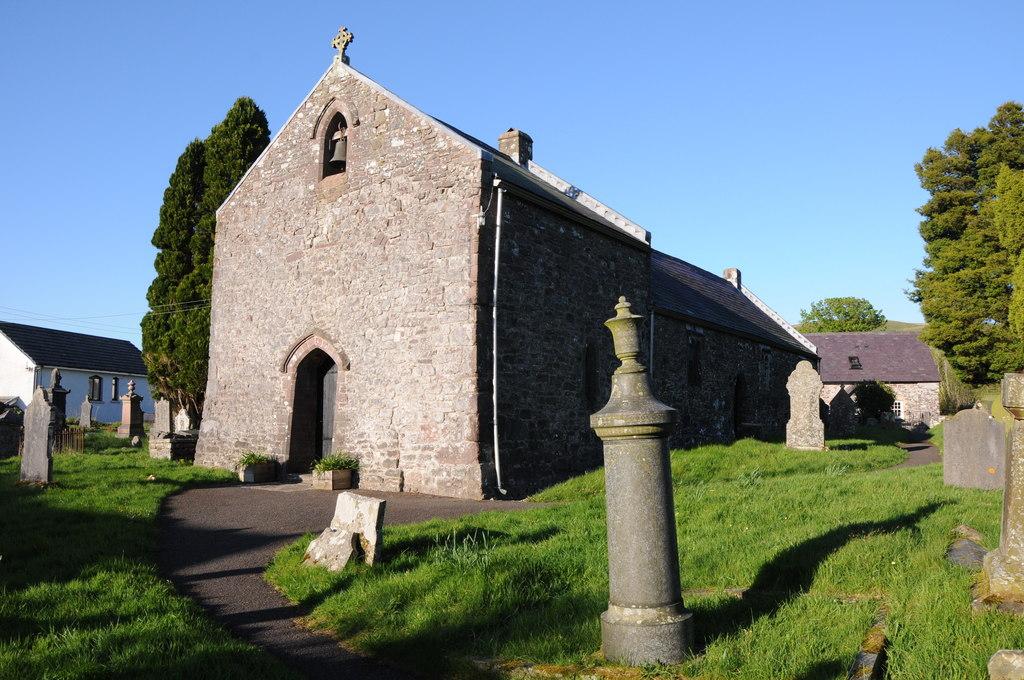St Michael
Myddfai, Carmarthenshire
The village of Myddfai is built around the churchyard of St Michael's.

From the churchyard full of orange hawkweed, knapweed and other native wild flowers there are spectacular views of the mountains with the legendary lake Llyn y Fan Fach, where a shepherd boy fell in love with a lady who appeared from the lake.
Llanddeusant, Dyfed
‘Having received his master’s blessing and kiss of peace, and leave to depart, he went forth and sought the seclusion of a certain desert place which adjoined his father’s possessions. There he built some cells and a little oratory, which they say, is now a monastic settlement containing numerous buildings bearing the name of his two brothers already mentioned. Here he received from the bishop the dignity of the priesthood and lived for some time with twelve presbyters who desired to obey his precepts in everything relating to the monastic life'.
Wrmonoc, a monk from Brittany, wrote the above in 884. He is referring to St. Paulinus, a 6th century monk who left his religious community in Llantwit Major to come to this wild and beautiful hamlet of Llanddeusant with his twin brothers Potolius and Notolius to found a new monastery. It was thought that the name Llanddeusant derived from these two brothers.
In 1983, Diane Brook noted a previously unrecorded cross slab purportedly dating from between the 6th and 8th centuries. The slab had the unceremonious use as a doorstep to a store shed belonging to the neighbouring Youth Hostel. Diane Brook wrote that it is ‘of coarse, gritty sandstone’ and has a ‘simple equal armed cross’ 2 inscribed on its upper surface. The stone has since been examined by other experts, all of whom have identified its material as concrete but probably of a more recent origin, perhaps the turn of the 20th century. However, there may still be other stones on the site worthy of investigation. The outer ‘Llan’, incorporating the old graveyard and vicarage walls, is oval in shape and dates from between the 6th and 8th centuries, a time when such walls were built with no corners in which the devil could hide.
It is said that building of the present day church began under the auspices of the Lady Anne in the 14th century. Legend tells us that initial building was started at Twynllanan some two miles away, where indeed there are now more houses, but at night the stones that had been laid that day were moved to the present site. Thus the building of the north aisle continued at this remote place, a continuous chain of workers bringing further stones up from the River Sawdde some half mile away to complete the northern aisle. A second south chamber was added in the 15th century along with the oak beamed barrel ceiling. A tower was later added at the southwest end of the church. This was hit by lightning during the late 18th century and reduced to a more conservative level in the early 19th century.
The 1885 Renovation Hywel Gwyn,MP and local landowner, was a descendant of the Lord Lieutenant’s daughter who lived at Blaensawdde in the valley south of the church. Gwyn instigated the 1885 renovation. The floor, having been previously raised to prevent flooding, now incorporated a coal fired central heating system. Ancient pews were replaced with the present pitch pine ones.
A further renovation was carried out in 1913. Although Hywel Gwyn had died by this time, this renovation was still carried out under his name. Large black memorial tablets, commemorating Gwyn’s family and other families of note in the parish were erected by the altar and around the northern aisle. During the following years, various alterations were made to the church, in particular to the heating, a constant problem in such a remote and exposed location. Electricity was installed in the 1960s and a large faithful coal stove was removed from beneath the central valley. The latter had served the congregations well, but involved the necessity of someone to constantly stoke it. The chimney hole was sealed, but proved a continuing difficulty. By the 1980s the congregation had dwindled to a dozen people who huddled around ineffective electric fires, whose singing was interspersed with continual dripping of rain into buckets under the now leaking sealed hole. During one service a jackdaw flapped across the altar, flew across the polite congregation before disappearing at the back of the church through a gap between the ceiling and wall.
In 1985, a renovation fund was set up to repair the leaking valley. By 1987, enough money had been raised to enable the then current Manpower Services Commission to embark on replacing the two inner slopes of the roof tiles. Removing the old tile stones, thick with tar and cement, vestiges of previous attempts to eliminate the rain, revealed beneath a horror of rotting roof timbers. This renovation was completed during the summer of 1988.
The lead lined font, although set on a modern shaped base, has an octagonal basin fashioned from a glacial conglomerate from the surrounding hills, during the 14th century. During his apprenticeship in Brecon, John Evan Thomas, sculptor of statues of the Duke of Wellington, Brecon and Prince Albert, Tenby, executed the Lewis family memorial on the north wall of the north aisle. North window by Robert Newbery in 1914.
This church is one of the oldest religious buildings in Wales. Please support us in our future plans to keep Llanddeusant church alive and open to visitors.
Myddfai, Carmarthenshire
The village of Myddfai is built around the churchyard of St Michael's.
Gwynfe, Carmarthenshire
The historic parish of Gwynfe itself has remained an agricultural area accessed only by narrow country roads.
Llangadog, Carmarthenshire
The peaceful village of Llangadog is situated in the Towy Valley.